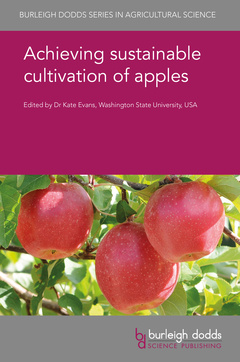Description
Achieving Sustainable Cultivation of Apples
Author: EVANS Kate
Language: English
Subject for Achieving Sustainable Cultivation of Apples :
Approximative price 321.26 €
In Print (Delivery period: 15 days).
Add to cart
Publication date: 06-2017
616 p. · Hardback
616 p. · Hardback
Description
/li>Contents
/li>Biography
/li>
Originating in Central Asia, apples are one of the most important fruits
globally and are grown in over 100 countries. Apple cultivation faces a
number of challenges. Increasing global competition has put the focus on
lowering costs whilst further improving sensory quality and shelf-life.
There is a need to reduce inputs such as water, fertiliser and labour,
both to save costs and reduce environmentally-damaging emissions and
pollution. There is a continual battle with fungal, viral and bacterial
diseases as well as insect pests. In the long term there is a need for new
varieties able to withstand disease or more extreme conditions associated
with climate change. This means preserving genetic variety and exploiting
new molecular breeding techniques opened up by the sequencing of the apple
genome in 2010.
Drawing on an international range of expertise, this collection focuses on ways of improving the cultivation of apples as a food crop at each step in the value chain, from breeding through to post-harvest storage. The book first reviews research in apple physiology and breeding. The following sections focus on cultivation techniques through to post-harvest storage, followed by a discussion of diseases and pests and their management. Concluding chapters address wider issues such as economics, consumer trends and sustainability.
Achieving sustainable cultivation of apples will be a standard reference for fruit and horticultural scientists in universities, government and other research centres and companies producing apples.
Drawing on an international range of expertise, this collection focuses on ways of improving the cultivation of apples as a food crop at each step in the value chain, from breeding through to post-harvest storage. The book first reviews research in apple physiology and breeding. The following sections focus on cultivation techniques through to post-harvest storage, followed by a discussion of diseases and pests and their management. Concluding chapters address wider issues such as economics, consumer trends and sustainability.
Achieving sustainable cultivation of apples will be a standard reference for fruit and horticultural scientists in universities, government and other research centres and companies producing apples.
Part 1 Plant physiology and breeding
. 1. Ensuring the genetic diversity of apples
. 2. The apple genome - harbinger of innovation for sustainable apple production
. 3. Advances in understanding apple tree growth: rootstocks and planting systems
. 4. Advances in understanding apple tree growth: the manipulation of tree growth and development
. 5. Advances in understanding flowering and pollination in apple trees
. 6. Advances in understanding apple fruit development
. 7. Evaluating and improving rootstocks for apple cultivation
. 8. Advances in marker-assisted breeding of apples
Part 2 Cultivation techniques
. 9. Innovations in apple tree cultivation to manage crop load and ripening
. 10. Advances in soil and nutrient management in apple cultivation
. 11. Mechanization and automation for apple production
. 12. Sustainable approaches to control postharvest diseases of apples
. 13. Advances in postharvest handling and storage of apples
Part 3 Diseases and pests
. 14. Pre- and postharvest fungal apple diseases
. 15. Management of viruses and virus-like agents affecting apple production
. 16. Bacterial diseases affecting apples
. 17. Sustainable arthropod management for apples
. 18. Advances in pest- and disease-resistant apple varieties
Part 4 Sustainability
. 19. The economics of apple production
. 21. Assessing the environmental impact and sustainability of apple cultivation
. 22. Growing organic apples in Europe
. 1. Ensuring the genetic diversity of apples
. 2. The apple genome - harbinger of innovation for sustainable apple production
. 3. Advances in understanding apple tree growth: rootstocks and planting systems
. 4. Advances in understanding apple tree growth: the manipulation of tree growth and development
. 5. Advances in understanding flowering and pollination in apple trees
. 6. Advances in understanding apple fruit development
. 7. Evaluating and improving rootstocks for apple cultivation
. 8. Advances in marker-assisted breeding of apples
Part 2 Cultivation techniques
. 9. Innovations in apple tree cultivation to manage crop load and ripening
. 10. Advances in soil and nutrient management in apple cultivation
. 11. Mechanization and automation for apple production
. 12. Sustainable approaches to control postharvest diseases of apples
. 13. Advances in postharvest handling and storage of apples
Part 3 Diseases and pests
. 14. Pre- and postharvest fungal apple diseases
. 15. Management of viruses and virus-like agents affecting apple production
. 16. Bacterial diseases affecting apples
. 17. Sustainable arthropod management for apples
. 18. Advances in pest- and disease-resistant apple varieties
Part 4 Sustainability
. 19. The economics of apple production
. 21. Assessing the environmental impact and sustainability of apple cultivation
. 22. Growing organic apples in Europe
Dr Kate Evans is Professor of Horticulture at the Tree Fruit Research and Extension Center at Washington State University, USA
© 2024 LAVOISIER S.A.S.

